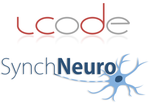|
|
|
Program
Below is the schedule of the Workshop. A short biography of the speakers is available here. 9:00 - 9:30: Registration and welcome coffee 9:30 - 10:30: Is population dynamics scale-invariant in the awake cerebral cortex?, by Alain Destexhe Several "macroscopic" variables of brain activity display evidence for scale invariance, such as the 1/f spectral structure of 10:30 - 11:30: Metastable dynamics and pattern storage in the context of cognition modelled by heterogeneous neural fields, by Axel Hutt Transient or metastable dynamics has been observed in experimental neural data for several decades whereas its origin is far from being understood. Examples are neural meta-stable attractors in neuron firing rates in the insect olfactory bulb, bird songs or event-related EEG components. After introduction, the talk presents a recently developed model of heterogeneous neural fields and how it describes storage and read-out of memory patterns and spatially extended meta-stable dynamics. An application to event-related potentials observed experimentally in cognitive experiments is explained in some detail. 11:30 - 12:30: Control of recurrent neural network dynamics by homeostatic intrinsic plasticity, by Bruno Cessac, J. Naudé, H. Berry, and B. Delord Homeostatic intrinsic plasticity (HIP) is a ubiquitous cellular mechanism regulating neuronal activity, cardinal for the proper functioning of nervous systems. Here, we assess how cellular HIP effects translate into collective dynamics and computational properties in biological recurrent networks. We develop a realistic multi-scale model including a generic HIP rule regulating the neuronal threshold with actual molecular signaling pathways kinetics, Dale’s principle, sparse connectivity, synaptic balance and Hebbian synaptic plasticity (SP). Dynamic mean-field analysis and simulations unravel that HIP sets a working point at which inputs are transduced by large derivative ranges of the transfer function. This cellular mechanism insures increased network dynamics complexity, robust balance with SP at the edge of chaos, and improved input separability. Although critically dependent upon balanced excitatory and inhibitory drives, these effects display striking robustness to changes in network architecture, learning rates and input features. Thus, the mechanism we unveil might represent a ubiquitous cellular basis for complex dynamics in neural networks. Understanding this robustness is an important challenge to unravel principles underlying self-organization around criticality in biological recurrent neural networks. 12:30 - 13:30: Lunch 13:30 - 14:30: Understanding Parkinson's disease, by Peter Wellstead and Mathieu Cloutier Medical texts describe the usual form of Parkinson’s disease (PD) as idiopathic (e.g. of unknown causes). In this talk we challenge this description with a systems view of PD. Specifically, we show how mathematical modelling of brain energy metabolism provides an objective framework for analysing PD. From a causal perspective, the model shows how brain energy deficits are the unifying theme that links the different risk factors for PD. A systems perspective also throws new light on the pathogenesis of PD. In particular, by adding known PD neurochemical mechanisms to the brain energy metabolism model, a neurochemical bistability - a Parkinson’s Switch - is revealed. The Parkinson’s Switch is a bistable systems mechanism that can be activated by any combination of PD risk factors. Based on this observation, we hypothesize that the Parkinson’s Switch is the core pathogenic mechanism for Parkinson’s disease and therefore a potentially important mathematical tool for investigating new therapies. 14:30 - 15:30: A minimal network mechanism accounting for universality in babbling vocalizations, by David Hansel Explorative behavior is a key concept in learning theory and is widespread during early stages of development. However how such behavior is actively generated by neuronal mechanisms is poorly understood. We show that babbling‐like vocalizations in human and non-human juvenile vocal learners share some common temporal features, which is in sharp contrast with the individual-specific learned vocalizations of the adults. These findings point toward the existence of a general neuronal mechanism for actively generating explorative behaviors. We theoretically investigate how neuronal variability can intrinsically emerge as a network property and then transferred to the effectors to generate an explorative behavior. More specifically, we explore how spatio-temporal correlations are naturally emerging in a balanced network with structured feed‐forward inputs and how these activity patterns are utilized by the effectors to generate explorative behavior with similar statistical properties as during babbling-like vocalizations. Finally, we give several testable predictions regarding the structure of spatiotemporal correlations in cortical-homologues areas responsible for babbling‐like vocalizations in juvenile songbirds. 15:30 - 17:00: Poster session 17:00 - 18:00: Electrophysiological Data and the Modelling of Brain Dynamics, by Dimitris Pinotsis and Karl Friston We will first provide an overview of a family of neural mass and field models that have been recently implemented using the Dynamic Causal Modelling (DCM) toolbox of the academic freeware Statistical Parametric Mapping (SPM). The SPM software is a popular platform for analyzing neuroimaging data, used by several neuroscience communities worldwide. In our survey of these models, we will introduce three fundamental dichotomies; namely the dichotomy between convolution and conductance dynamics, the dichotomy between neural mass and mean field formulations and the dichotomy between point sources and neural field models. We will then focus on induced responses of neural masses and fields that are sensitive to biophysical properties of local cortical circuits like synaptic kinetics and filtering. We will also describe how neural fields include horizontal intrinsic connections within laminae of the cortical sheet and model current fluxes as continuous processes, using partial differential equations (PDEs). We will shed light on different uses of neural fields and put forward reasons why these models can be useful in the analysis of neuroimaging data. We will argue that neural fields allow one to: (i) compare evidences for alternative hypotheses regarding the important neurobiological determinants of stimulus-specific response variability; (ii) make inferences about between subject variability in cortical function and microstructure using non-invasive data and (iii) obtain estimates of spatial parameters describing cortical sources in the absence of spatially resolved data.
|


